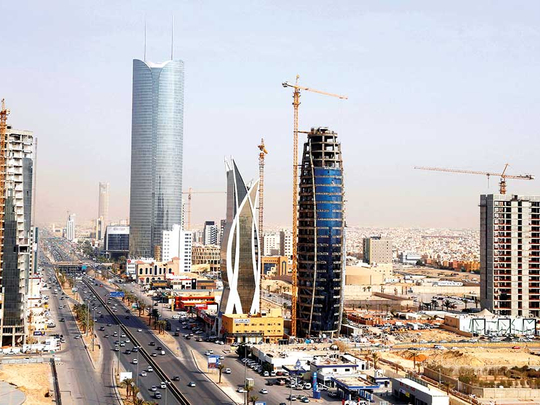
Riyadh: Saudi Arabia’s government expects record spending to deliver a strong economic rebound in 2018. Economists say it’s too optimistic, with officials underestimating the impact of new taxes, subsidy cuts and oil prices.
Even after King Salman ordered additional cash handouts this month to mitigate the toll of austerity on households, the median estimate of five economists surveyed by Bloomberg is 1.6 per cent growth — well below the 2.7 per cent in the Saudi budget — with predictions ranging from 0.7 per cent to 2 per cent.
Below are some key reasons for economists’ scepticism:
Oil still king
The government is planning record spending this year to boost growth and help companies adjust to Crown Prince Mohammad Bin Salman’s strategy to reduce the kingdom’s dependence on oil.
But despite efforts to diversify, oil remains key, and the budget includes a 12 per cent jump in crude revenue. That’s based on a price of about $63 per barrel, according to estimates by Bloomberg Economics.
Brent crude is trading at almost $70 a barrel. But the price was $115 as recently as 2014, and the still only partial recovery weighs on the broader economy and not just the oil sector, said Raphaele Auberty, Middle East and North Africa country risk analyst at BMI Research, which predicts overall growth of 1.6 per cent this year. “We’re definitely more cautious than the Saudi government,” she said.
Assessing handouts
Several of the economists raised their growth estimates after Saudi Arabia said it would spend an additional 50 billion riyals to boost civil servant salaries and ease the burden of a new value-added tax and subsidy cuts on citizens.
Though significant, it won’t be enough to bring non-oil growth in line with the government’s 3.7 per cent forecast, according to Ziad Daoud, chief Middle East economist for Bloomberg Economics. That’s up from 1.5 per cent in 2017.
“It’s really hard to get that 3.7 per cent figure — even if we assume that people will spend all the additional income they’ll get from the government,” he said.
Tax strain
A value-added tax of 5 per cent, tripling of electricity tariffs for some customers and higher gasoline prices all took effect on January 1, raising the cost of living for many Saudis. Companies also face new fees to employ foreign workers, and a levy on foreigners’ dependents will increase in July.
The government’s handouts and a cash-transfer programme in place since December to compensate lower-income households for the changes won’t fully offset their impact, Monica Malik, chief economist at Abu Dhabi Commercial Bank, said in a research note.
“On an individual household basis, we believe that some will not be fully insulated from the impact of fiscal reforms, particularly those working in the private sector and expatriates,” she said. Malik predicts 1.4 per cent non-oil growth and an overall 0.7 per cent expansion in Saudi Arabia this year.
Shake-up
Mohammad Bin Salman’s shake-up is aimed at making Saudi Arabia’s economy fit better with the modern world. The reform programme includes selling a stake in the state-run oil giant Aramco, opening the stock market to more foreign investment and creating the world’s largest sovereign wealth fund.
But there have also been significant shocks. The November arrest of dozens of prominent princes and businessmen, including billionaire investor Prince Alwaleed Bin Talal, in a stated corruption probe is the most obvious example; the spat with neighbouring Qatar is another.
“Uncertainties linked to the impact of the anti-corruption probe on the private sector, the breakdown of the stimulus package, and the funding and timing of off-budget mega-projects keep us conservative on our growth assumptions,” Bank of America Merill-Lynch economist Jean-Michel Saliba said in a recent research note. He revised his growth estimate to 1.7 per cent from 1.3 per cent after the announcement on handouts.
Aramco ready to IPO in second half, awaiting govt decision on venue — CEO
Saudi Aramco’s Chief Executive Amin Nasser said on Thursday that the initial public offering (IPO) of the state oil giant is still planned for the second half of 2018, but the government has not yet made a decision on the listing venue.
“The company is ready for listing in 2018 when the decision is taken on the listing venue,” Nasser told reporters at the company’s headquarters.
“We want to see if there is going to be a listing in another market (in addition to the Saudi Tadawul). There is a committee that is formed that looks into it and whenever the decision is taken the company is ready to implement.” The sale of up to 5 per cent of Saudi Aramco, is a centrepiece of Vision 2030, an ambitious reform plan to reduce the economy’s dependence on oil.
Nasser said the plan remains to list the whole company rather than creating a subsidiary to IPO.
— Reuters












